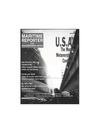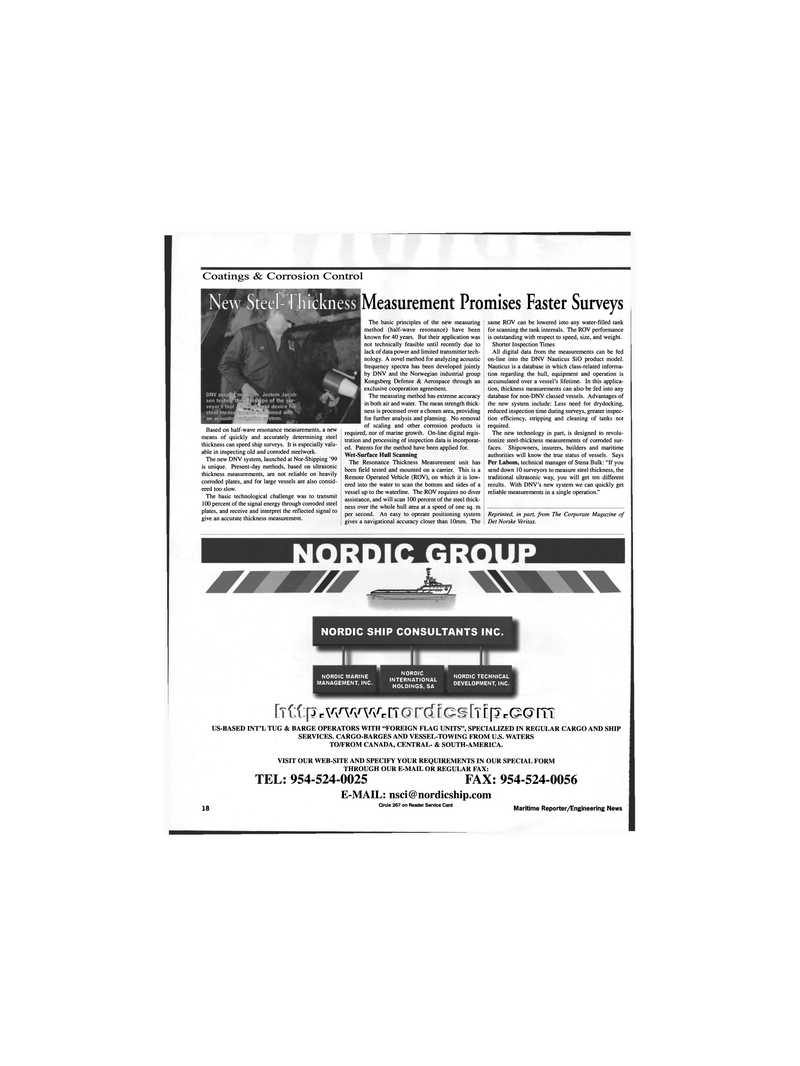
Page 18: of Maritime Reporter Magazine (August 1999)
Read this page in Pdf, Flash or Html5 edition of August 1999 Maritime Reporter Magazine
Coatings & Corrosion Control
Measurement Promises Faster Surveys same ROV can be lowered into any water-filled tank for scanning the tank internals. The ROV performance is outstanding with respect to speed, size, and weight.
Shorter Inspection Times
All digital data from the measurements can be fed on-line into the DNV Nauticus SiO product model.
Nauticus is a database in which class-related informa- tion regarding the hull, equipment and operation is accumulated over a vessel's lifetime. In this applica- tion, thickness measurements can also be fed into any database for non-DNV classed vessels. Advantages of the new system include: Less need for drydocking, reduced inspection time during surveys, greater inspec- tion efficiency, stripping and cleaning of tanks not required.
The new technology in part, is designed to revolu- tionize steel-thickness measurements of corroded sur- faces. Shipowners, insurers, builders and maritime authorities will know the true status of vessels. Says
Per Labom, technical manager of Stena Bulk: "If you send down 10 surveyors to measure steel thickness, the traditional ultrasonic way, you will get ten different results. With DNV's new system we can quickly get reliable measurements in a single operation."
Reprinted, in part, from The Corporate Magazine of
Det Norske Veritas.
Based on half-wave resonance measurements, a new means of quickly and accurately determining steel thickness can speed ship surveys. It is especially valu- able in inspecting old and corroded steelwork.
The new DNV system, launched at Nor-Shipping '99 is unique. Present-day methods, based on ultrasonic thickness measurements, are not reliable on heavily corroded plates, and for large vessels are also consid- ered too slow.
The basic technological challenge was to transmit 100 percent of the signal energy through corroded steel plates, and receive and interpret the reflected signal to give an accurate thickness measurement.
The basic principles of the new measuring method (half-wave resonance) have been known for 40 years. But their application was not technically feasible until recently due to lack of data power and limited transmitter tech- nology. A novel method for analyzing acoustic frequency spectra has been developed jointly by DNV and the Norwegian industrial group
Kongsberg Defense & Aerospace through an exclusive cooperation agreement.
The measuring method has extreme accuracy in both air and water. The mean strength thick- ness is processed over a chosen area, providing for further analysis and planning. No removal of scaling and other corrosion products is required, nor of marine growth. On-line digital regis- tration and processing of inspection data is incorporat- ed. Patents for the method have been applied for.
Wet-Surface Hull Scanning
The Resonance Thickness Measurement unit has been field tested and mounted on a carrier. This is a
Remote Operated Vehicle (ROV), on which it is low- ered into the water to scan the bottom and sides of a vessel up to the waterline. The ROV requires no diver assistance, and will scan 100 percent of the steel thick- ness over the whole hull area at a speed of one sq. m per second. An easy to operate positioning system gives a navigational accuracy closer than 10mm. The
NORDIC SHIP CONSULTANTS INC.
NORDIC MARINE
MANAGEMENT, INC.
NORDIC
INTERNATIONAL
HOLDINGS, SA
NORDIC TECHNICAL
DEVELOPMENT, INC.
JrWWWrTT tT[?r(?(?rr[
US-BASED INT'L TUG & BARGE OPERATORS WITH "FOREIGN FLAG UNITS", SPECIALIZED IN REGULAR CARGO AND SHIP
SERVICES. CARGO-BARGES AND VESSEL-TOWING FROM U.S. WATERS
TO/FROM CANADA, CENTRAL- & SOUTH-AMERICA.
VISIT OUR WEB-SITE AND SPECIFY YOUR REQUIREMENTS IN OUR SPECIAL FORM
THROUGH OUR E-MAIL OR REGULAR FAX:
TEL: 954-524-0025 FAX: 954-524-0056
E-MAIL: [email protected] 18 Circle 267 on Reader Service Card Maritime Reporter/Engineering News

 17
17

 19
19
